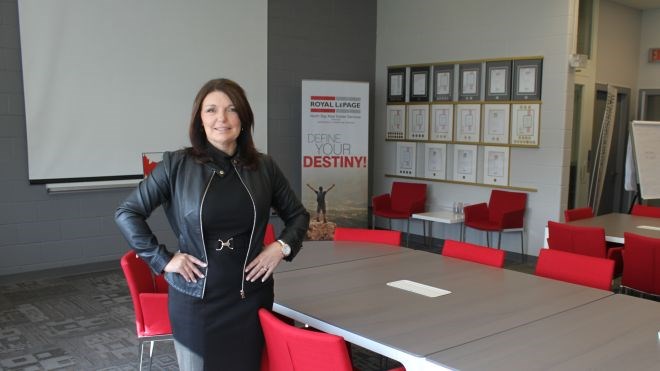Before she moved her business into its current location in the heart of North Bay, realtor Sue Symons would often park outside the unused building and dream of what it could be. It had long since outgrown its use as an elementary school and sat vacant, just waiting for a new purpose.
“I just loved the building, and we were actively looking for space, but to find the right space that’ll give you growth, that’s the right location, with enough parking and all of that took a little time,” said Symons, owner and broker of record at Royal LePage North Bay Real Estate Services.
“So I was pretty excited when the school board decided to sell this.”
The 8,900-square-foot building, constructed around 1963, came up for tender in November, 2015, and Symons successfully bid to purchase it, taking possession on Dec. 18. But with its location in a residential area, the property had to first be rezoned for commercial use, and Symons spent most of 2016 going through the rezoning process.
Repurposing old buildings for different uses is nothing new. But in North Bay, as in other Northern communities, commercial land is becoming scarcer, and so business owners are getting creative in tracking down their ideal property.
In North Bay, Symons said with people having fewer children, and congregations shrinking, an abundance of schools and churches have come up for sale, particularly in the last two years. Savvy business owners know that a hidden gem could be waiting in one of these properties.
“Building (new) is quite costly, and in some cases, building brand new makes sense, depending on what your business is, or if you’re an industrial or commercial business and you need a specific factory,” said Symons, who estimated building new would have cost her three times what she spent refurbishing the school.
“For us, if it’s not going to be a school anymore, what would be the best use of this building? Offices.”
After getting approvals in place, Symons set a lightning fast timeline of three and a half months for the refurbishment’s completion. Acting as her own general contractor, Symons hired all local tradespeople and purchased local supplies wherever possible.
“Everybody that worked on site was supportive of my timeline, respectful of my budget, and gave me respect knowing that I was new to this,” said Symons, who hadn’t before taken on a commercial project of this size.
Symons met her timeline, getting occupancy on Nov. 29, and moving in two days later.
But the search for a new workspace was even more exhaustive for John O’Rourke, a 32-year veteran cabinetmaker, who owns The Brownstone.
For years, he had been working out of two showrooms, side by side, and a third warehouse location, which was at a different site. There wasn’t enough space, and it was inconvenient, but moving was easier said than done.
“For four years, we were looking, and we’d get frustrated, because you’d see buildings and that wasn’t it, or I saw a building I did like and it was just so overpriced,” he said.
“I found this one, and because it was such an ugly building, I thought, ‘OK, now I can afford to make it my building.’”
His “ugly building” was a former machine shop, with mismatched yellow cladding, mouldy walls, and everything caked in oil and grit. But in it, he saw opportunity and purchased the building last September.
It’s since undergone a complete transformation, inside and out. The expansive showroom, which highlights his custom cabinetry, is thoughtfully sectioned into easy-to-navigate areas, and rustic wood trusses, added for architectural effect, give a cozy feel to the 23-foot ceilings.
His bathroom is fully accessible and features a wall adorned in 100-year-old reclaimed wood, hauled up from the Kipawa River. And that ugly outdoor cladding has been replaced with stone and a warm brown façade, which is punctuated by large picture windows to let in natural light.
The space is functional, too. O’Rourke now has room and capacity for all his cabinet-making equipment, thanks to 600-volt power, including one machine he’s using for the first time in more than a decade.
“At my old warehouse, I didn’t have 600 volts, so that (machine) sat there for 11 years collecting dust,” he said.
O’Rourke said the work was exhausting, and he surpassed his initial budget, but he believes it’s worth it. He now has the facility of his dreams, with plenty of room to expand as his business grows.
“I wanted to have a first-class facility that is 100 per cent compliant with every code that is out there,” he said. “I have no regrets.”
Nearing the one-year anniversary of moving into her new space, Symons, too, is confident that the decision was the right one.
The new office — professional, yet welcoming — is decorated in soft greys and creams, and artwork by local artists fill the walls. It has enough room to house the 26 agents currently working at Royal LePage, but with enough room to expand in the future.
Offices are configured to make use of the many windows through the building, and lots of drywall went up to jazz up the cinder block structure. The gym has been transformed into a meeting and training room, which Symons also opens up for use by the community.
But more than anything, the location is proving ideal, as hoped. Situated directly across from the Memorial Gardens arena and the YMCA, the office catches traffic from two major thoroughfares that intersect at that junction.
“One thing they’re not making more of is land, and one thing you cannot change in real estate is location,” Symons said.
“So, for me, it was always about location first and then see if you can find something in that location that you can renovate to meet your needs, because there isn’t a lot of vacant commercial land in the city.”




